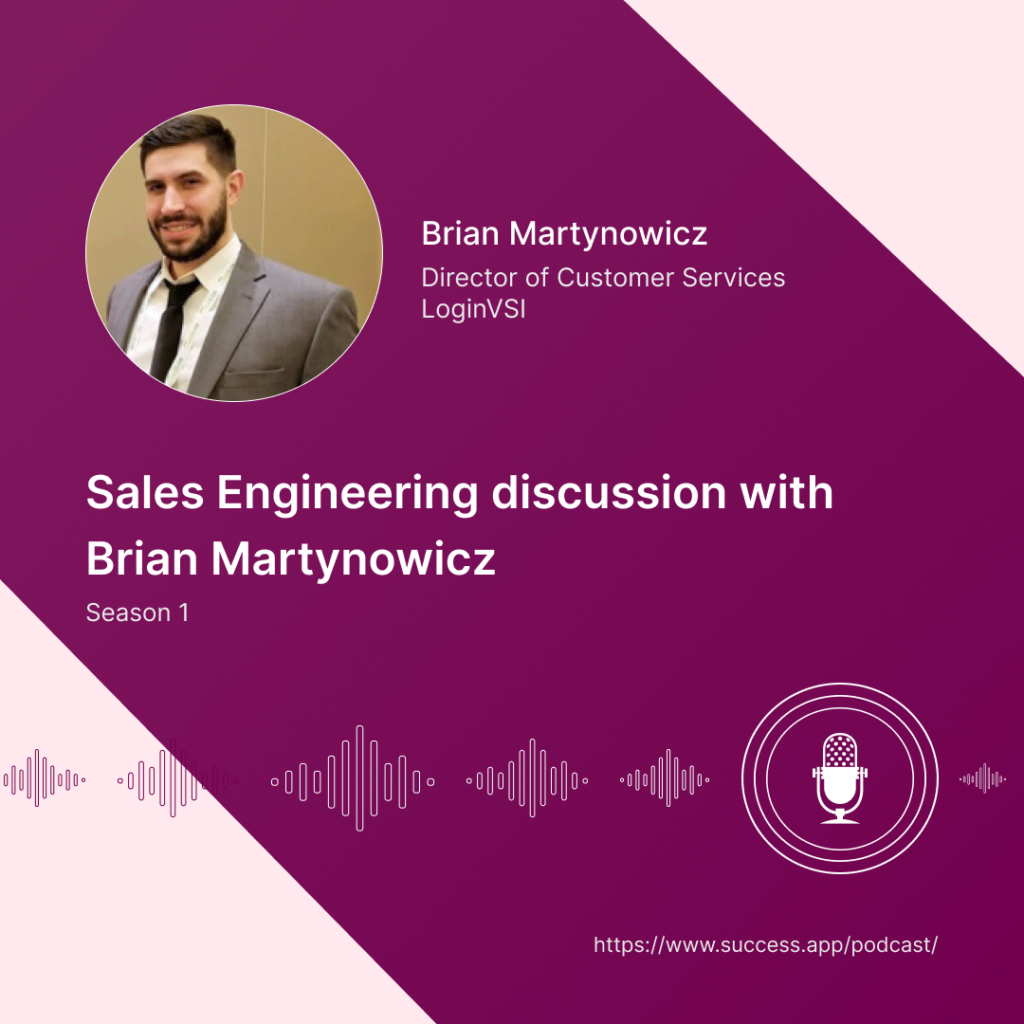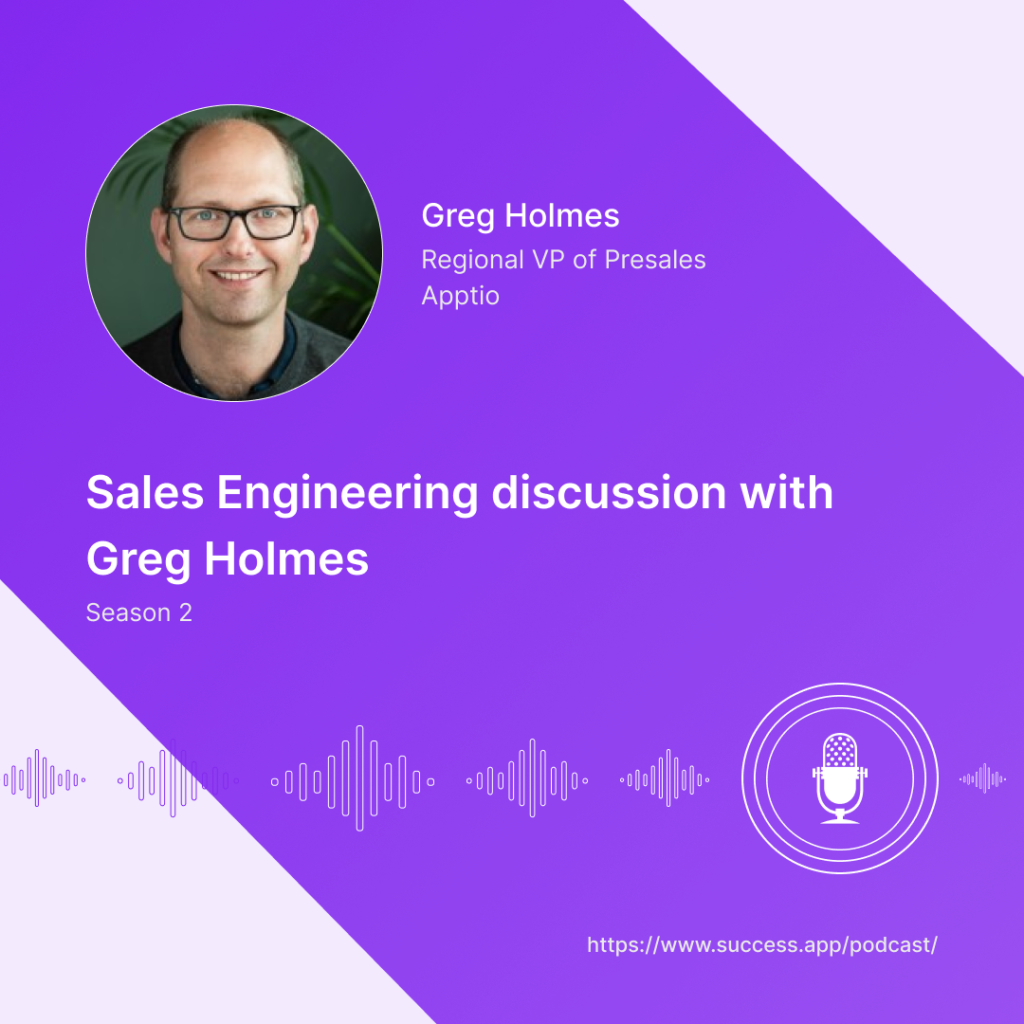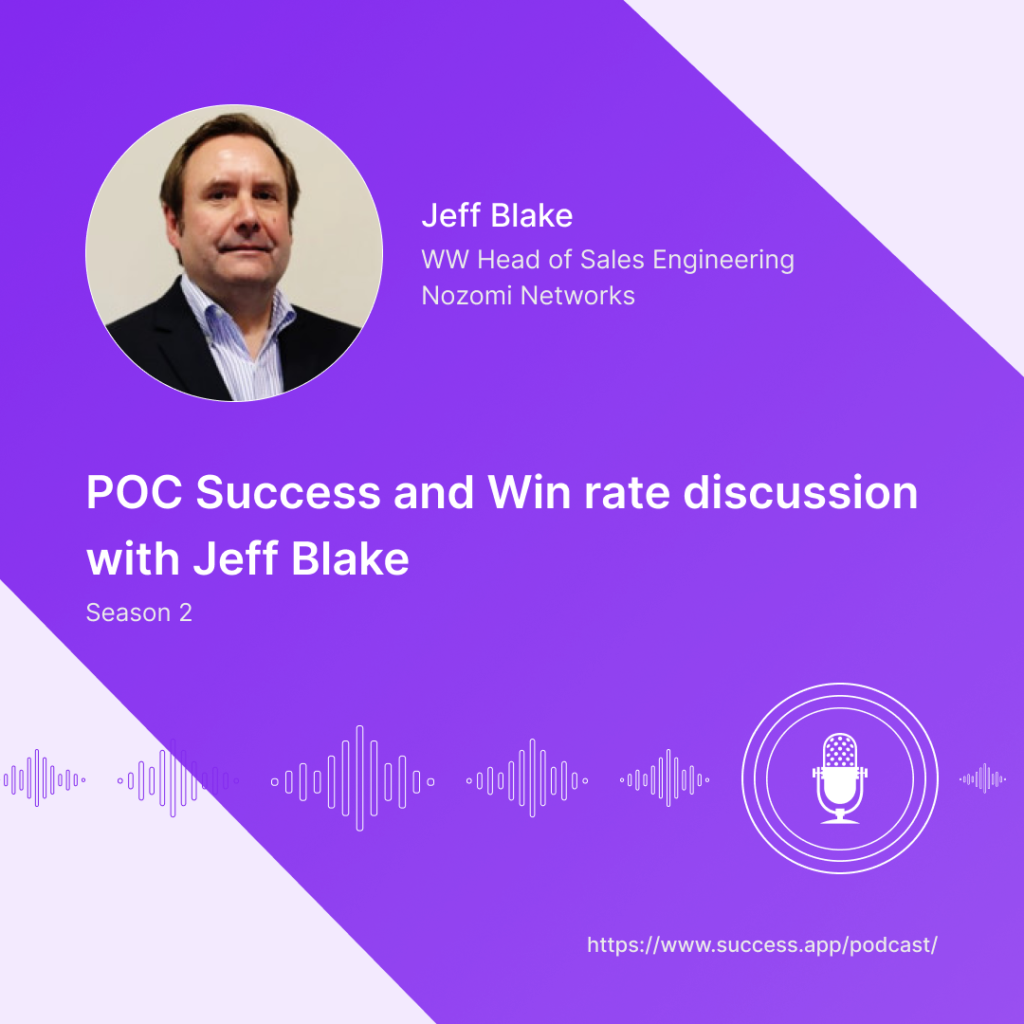

Director of Customer Services at LoginVSI
Brian Martynowicz, Director of Customer Services at LoginVSI joins as a guest in this episode. Brian and Vik discuss about pre-sales and post-sales topics.
[00:00:00] Intro: Welcome to podcast for sales engineers, Proof is in the Pudding. This podcast is brought to you by smart POC platform, Pudding.app and I’m your host Vik Arya.
[00:00:13] Vik: In this podcast episode, we bring you the Director of Customer Services at Login VSI. We have Brian Martynowicz in our show today. Hi Brian, how are you?
[00:00:23] Brian: Good. How are you?
[00:00:24] Vik: Good. Thank you. Uh, Brian, can you tell a little bit more to our listeners about yourself, what you’ve been doing and a little bit about your role?
[00:00:32] Brian: Absolutely. So, my name is Brian Martynowicz, I’m the Director of Customer Services at Login VSI. Um, I’ve been in the IT industry for around 17 years now.
[00:00:42] Um, my background is in engineering, started in a help desk support and, uh, moved up to my current role as the Director of Customer Services for VSI. Login VSI is around a hundred percent software company, specializing in a tool set for helping IT engineering, manage user experience, and large-scale virtual desktop and published application configurations.
[00:01:09] So, that’s a little background about me.
[00:01:11] Vik: Great. So, one thing is, about Brian is he publishes these amazing posts on LinkedIn, which, which are always fun to see. And recently working from home, I saw you posting a wall walk that you were doing, so.
[00:01:25] Brian: That’s right. Yup. You got to keep your mind and body occupied, um, you know, with what’s going on right now.
[00:01:32] Vik: Right. So, uh, one thing about, uh, you, you know, your role that I really want to explore as you work in both pre-sales and post-sales roles.
[00:01:41] Brian: That’s correct. Yup.
[00:01:42] Vik: It’s kind of a, It’s the end-to-end customer journey beginning when they’re looking to buy a product and then using it and then keeping the customer over a year over year.
[00:01:49] Brian: That’s correct. Yup.
[00:01:50] Vik: So, I want to talk a little bit about your transition or, or in terms of your experience as I, in the role of a customer services and how do you see the pre-sales and post-sales roles working together.
[00:02:01] Brian: Absolutely. Um, so, you know, when you talk about pre-sales, you’re really talking about the customers getting their first introduction to not only the software, but the company as a whole.
[00:02:11] So that first impression, and, you know, as cliche as it is to say really is important, right? So, you’re, you know, you’re the engineering tip of the spear, um, educating the enterprise customer about the importance of, of managing end user experience in our particular uh, instance, once it transitions into, you know, becoming a customer then, then the entire, uh, processes is definitely different.
[00:02:38] It becomes less about the amount of time and more about being thorough and making sure, you know, the appropriate risk mitigation processes are in place and that sort of thing.
[00:02:49] Vik: Right. So, one thing that I always liked to ask my guests about the metrics that they’re tracking and the reason is because typically we track the metrics because we want some information out of it.
[00:03:02] We want to make sure that data is clean and we are getting the right output of those metrics and we can strategize and figure it out. What is working? What is not working?
[00:03:12] Brian: Absolutely.
[00:03:12] Vik: In that regard I want to ask you. What are some of the metrics that you are tracking, let’s say within the quarter or quarter over quarter, year over year, uh, in pre-sales and post-sales that you find really useful and what kind of analysis that you do, which can be used for other people to share?
[00:03:29] Brian: Absolutely. So, um, you know, every activity within the engineering team at Login VSI is passed through our ITSM. We use Zendesk out, um, uh, for management, right. Everything that’s done is then, you know, applied and, and captured as far as, from a metric standpoint, if it’s like the number of tickets, the, the duration of time that tickets are open.
[00:03:53] Um, we offer satisfaction surveys, um, with each of them, we run NPS scores and promotions. When you’re talking about pre-sales, we’re monitoring uh, the amount of time that it takes, the average length, uh, the maximum length, the volume, um, but really just looking at the metrics in general, don’t tell the whole story.
[00:04:15] So we, we definitely then, you know, divide those up and, and see what kind of patterns that we can drive, uh, from them specifically.
[00:04:23] Vik: Right. You mentioned something very interesting about measuring the time as a metric in a POC. In a successful POC, what are, what do you think some of the features are, or what are the patterns that you find when a POC is successful versus one they’re not.
[00:04:40] Can you share some of your experience there?
[00:04:43] Brian: Great, great question. Um, what we find is that time really is the most critical success factor when you’re talking about proof of concepts specifically, right? Um, the amount of time really matters, especially in our industry. Um, because what we find is as time progresses interest and opportunity begins to, um, begin to stray.
[00:05:03] So that’s a really important one for us. So, any way in which we can um, manage the amount of time that it takes for these things to occur is of, of very, uh, high interest to us.
[00:05:16] Vik: Right. And I think, uh, in, in that order, uh, just want to, um, also talk about some of the processes that you put in place to make sure that, you know, we are, uh, you know, or, you know, your POCs are following.
[00:05:31] They’re not as long as the other ones. How do you make sure what are the processes you put in place to make sure that POC are moving quickly?
[00:05:39] Brian: Yup. Sure. So, uh, if first off starts with, with tracking it, right? So, we need to make sure, sure that these things are accounted for within our systems. Right. Uh, then a stopwatch begins right from the moment that that opportunity as a POC is open until the moment that it is closed is completely tracked.
[00:05:57] There’s a variety of steps within that, but. But that’s the majorly important thing that we focus on. We find that when we can drive the amount of time down, we can increase our success factor. So, we’ll look at the number of these that we’re doing, uh, how long they take. Um, and then we’ll actually do a retrospective on each of them to, to drill into the individual details, but really like, time is important.
[00:06:18] So then we’ll look at that. We’ll understand it. We’ll develop processes, uh, like looking at tooling, for example, or providing additional information, uh, removing roadblocks that we’ve, we’ve run into over and over again. Um, and we really feel strongly that providing the most amount of information to our customers as possible.
[00:06:39] It really is. Uh, Is a factor of success as well.
[00:06:42] Vik: Yeah, I think I agree with that. I, especially during the POC where customers looking for a why this tool or why this product is the best fit for the environment, it’s always good to provide them information and, uh, whatever is possible so they can make the, you know, they get the right perspective, why they are doing the POC, what is coming out.
[00:07:03] Brian: Absolutely, Yup.
[00:07:04] Vik: Now, I want to talk to you so you have been, uh, using Pudding for awhile, what stood out for you in Pudding, uh, and what you think, how Pudding can help in managing the POCs?
[00:07:16] Brian: Um, once we had kind of gotten into the software, it became readily apparent to me how it would address those areas that I had just mentioned.
[00:07:23] Right. So, creating monitored, monitorable um, metrics, for example, Uh, understanding, you know, when those metrics cause an exception that you should pay attention to providing information, um, to your customers, right? So, you can provide documentation back, back and forth. You can create checklists to make sure that everyone’s on the same page.
[00:07:48] Um, and, and so that’s what really in my mind was, uh, was really interesting to me. What I would say, is anyone that’s listening to this understands the critical nature and, and whether or not a company is successful, kind of is dependent upon their ability to demonstrate their software. I can’t emphasize more that removing cycles from a time perspective and how critical it is.
[00:08:13] And, you know, I really appreciate. You know, people like you, Vik that are out there trying to make this easier for people like me. So, thanks so much.
[00:08:21] Vik: That sounds good. Thank you. Um, that kind of wraps up our podcast for today.
[00:08:31] Outro: Pudding is a smart POC platform that elevates the POC experience for sales teams and their customers. Sales engineering teams use Pudding for tracking, managing, and automating POC activities. Find out more at pudding.app.

In this week's episode of Proof is in the Pudding podcast, Vik is joined by Greg Holmes, Regional Vice President of Presales at Apptio. Greg shares his views on the evolution of presales, best practices for POC, product evaluation process, his contribution to the PreSales Collective, and more exciting topics.

In this episode, Jeff and Vik discuss fundamental sales engineering activities, defining winning success criteria, POC success rate, key insights for SE's, and many other sales engineering topics.